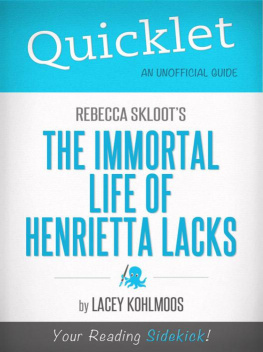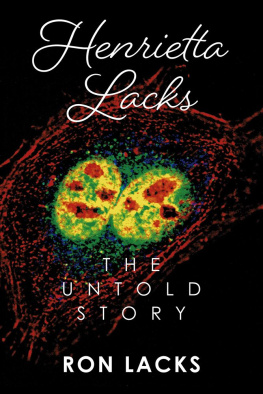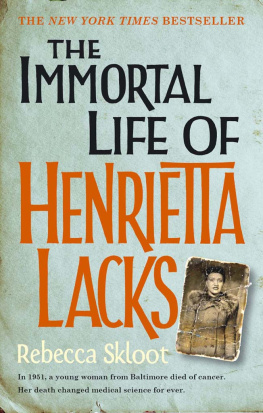Quicklet on Rebecca Skloot's The Immortal Life of Henrietta Lacks
I.
Quicklet on Rebecca Skloot's The Immortal Life of Henrietta Lacks
About the Book
Shes the most important person in the world and her family living in poverty. If our mother is so important to science, why cant we get health insurance?
Henrietta Lacks was a beautiful African American woman who always painted her toenails red. She loved to dance. She had a big laugh and mischievous eyes. She had five children whom she loved with every inch of her soul. No one knows what her favorite color was.
Henrietta Lacks was full life, but she died in 1951, her body consumed by tumors that had started in her cervix. She was buried in an unmarked grave and even though she was greatly loved, no one talked much about Henrietta after she died. The winds of time would have quickly swept away all signs of this vivacious woman had it not been for one thing: her cells were immortal.
You see, before Henrietta Lacks died, her doctor at Johns Hopkins took a sample of her cancerous cervical tissue and gave it to a colleague who was attempting to grow cell cultures. Unlike all of the other cells that died soon after they were put into a petri dish, Henriettas cells lived onand onand on.
When Henrietta died, she not only left behind her husband and five children, left HeLa a strain of immortal cells that have played a role in saving and improving the lives of millions of people all over the world.
Rebecca Skloots first novel, The Immortal Lives of Henrietta Lacks , tells the story of Henrietta Lacks, HeLa, and Lacks familys struggles after Henriettas death. The story that Skloot unravels so eloquently is not a simple biography or scientific exposition, however, it is an unflinching commentary on medical ethics, race, religion. It is a story of doubt, redemption, fear, and opening ones heart and mind to others.
Skloot spent ten years working with the Lacks family to research and write The Immortal Lives of Henrietta Lacks. In the end Skloot becomes as much a part of the narrative as Henrietta, struggling alongside the Lacks descendents as they strive to find answers to questions unanswered for decades. This is a book that challenged the authors way of thinking as much as it challenges the readers. It is a non-fiction masterpiece that will live on for as long as the HeLa cells that sparked its creation.
Introducing the Author
In that moment, reading those passages, I understood completely how some Lackses could believe, without doubt, that Henrietta had been chosen by the Lord to become an immortal being.
Rebecca Skloot was born on September 19, 1972 in Springfield, Illinois. Her father, Floyd Skloot, was a writer and her mother, Betsy McCarthy, was a professional knitter and hospital administrator.
The Skloot-McCarthy family moved to Portland, Oregon when Rebecca was 11 years old . She attended West Sylvan Middle School and then went on to Lincoln High School. After a rough year at Lincoln, Rebecca transferred to the Metropolitan Learning Center and took classes at the local community college to make up high school credits. It was during a community college biology class that Rebecca first heard about Henrietta Lacks and the HeLa cells .
Rebecca graduated in 1997 from Colorado State University with a Bachelor of Science in Biology, but discovered in a creative writing course that she also had a knack for writing . She earned her Master of Fine Arts in creative nonfiction from the University of Pittsburgh in 2008.
Rebecca specializes in narrative science writing , and over the last decade, her work has appeared in publications such as O, The Oprah Magazine ; The New York Times ; and Discover . She has also worked as a correspondent for PBSs ScienceNOW and WNYCs Radiolab.
The Immortal Life of Henrietta Lacks , Rebeccas first book, was published on February 2, 2010 and became an instant hit. Not only did it debut #5 on the New York Times Bestseller List, The Immortal Life was also beloved by critics across the board.
Rebecca currently lives in Chicago , but is more often writing in West Virginia or traveling all over the nation giving talks on bioethics, The Immortal Life, and how to get a book published.
Overall Summary
Theres a photo on my wall of a woman Ive never met, its left corner torn and patched together with tape. She looks straight into the camera and smiles, hands on hips, dress suit neatly pressed, lips painted deep red. Its the late 1940s and she hasnt yet reached the age of thirty. Her light brown skin is smooth, her eyes still young and playful, oblivious to the tumor growing inside her a tumor that would leave her five children motherless and change the future of medicine. Beneath the photo, a caption says her name is Henrietta Lacks, Helen Lane or Helen Larson.
Henrietta Lacks was born on August 1, 1920 in Roanoke, Va, but grew up on her grandfathers tobacco farm in Clover, VA. She married her cousin, David Day Lacks, and together had five children. The steel industry was booming during World War II, so Day and Henrietta moved to Turners Station outside of Baltimore, MD where he could find a good job.
In 1951, Henrietta went into Johns Hopkins to see a doctor about pain and swelling in her abdomen. He quickly diagnosed her with cervical cancer and started radiation treatments. During a treatment-related surgery, Henriettas doctor took a sample of her cancerous tissue without her knowledge and sent it to Dr. George Gey, a colleague attempting to grow cells in his lab. Unlike all of the other samples, Henriettas cells lived and grew rapidly. It was a huge scientific breakthrough.
After months of painful treatments and a short period of remittance, Henriettas tumor spread throughout her entire body and she died less than a year after her first doctors visit. She left behind five children Elsie, Lawrence, Sonny, Deborah, and Joe three of which soon fell under the care of two cousins who physically abused them until Lawrences girlfriend found out and brought them under their roof. Elsie, the eldest child died in a mental institution shortly after Henriettas death.
News of Henriettas cells, now called HeLa, spread quickly throughout the medical community. Dr. Gey gave HeLa to anyone who wanted it for experiments and pretty soon an entire multi-billion dollar industry rose out of culturing Henriettas cells and selling them. Due to new practice of doctor-patient confidentiality, however, Dr. Gey never revealed the true identity of the cells original donor. No one, including the Lacks family, knew that it was Henriettas immortal cells behind some of the greatest medical advances of the time.
It was not until Dr. Geys death in 1973 that Henrietta Lackss name was known as the donor of the HeLa cells. Soon doctors and reporters were contacting the Lacks family about the cells. Deborah and her siblings were astonished to find out about the cells and never quite understood how Henrietta could be immortal when she was dead. The following decades of miscommunication surrounding HeLa made the family resentful of the fact that Henriettas cells helped millions while her own family cant afford health insurance. The attempted scams and exploitative journalists that fell upon the family during the 1980s and 1990s also made the Lackses distrustful of anyone contacting them about the cells.
And then along came Rebecca Skloot. Rebecca had always been fascinated by the story of the woman behind HeLa and decided that she wanted to write a book on the subject. She contacts the Lacks family in early 1999 without success, but travels to Clover, Va where the Lacks cousins happily talk to her. Unfortunately, information on Henrietta is pretty scarce.












